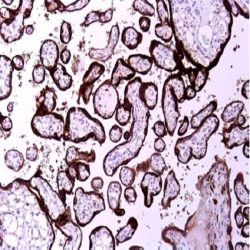دسته: آنتی بادیهای ایمونوهیستوشیمی
نمایش 81–100 از 923 نتیجه
فیلتر ها-
آنتی بادیهای ایمونوهیستوشیمی
آنتی بادی TCR C Gamma M1 (H-41)
نمره 0 از 5Name: TCR gamma M1 Antibody Clone H-41
Description and applications: The antibody detects TCR C gamma M1 which has a predicted molecular
weight of approximately 18 kDa.
The ability of T cell receptors (TCR) to discriminate foreign from self-peptides presented by major histocompatibility complex (MHC) class II molecules is essential for an effective adaptive immune response. TCR recognition of self-peptides has been linked to autoimmune disease. Mutant self-peptides have been associated with tumors. Engagement of TCRs by a family of bacterial toxins know as superantigens has been responsible for toxic shock syndrome. Autoantibodies to V beta segments of T cell receptors have been isolated from patients with rheumatoid arthritis (RA) and systemic lupus erythematosus (SLE). The autoantibodies block TH1-mediated inflammatory autodestructive reactions and are believed to be amethod by which the immune system compensates for disease.
T Cell and TCR Diversity Most human T cells express the TCR alpha-beta and either CD4 or CD8 molecule (single positive, SP). A small number of T cells lack both CD4 and CD8 (double negative, DN). Increased percentages of alpha-beta DN T cells have been identified in some autoimmune and immunodeficiency disorders. Gamma-delta T cells are primarily found within the epithelium. They show less TCR diversity and recognize antigens differently than alpha-beta T cells. Subsets of gamma-delta T cells have shown antitumor and immunoregulatory activity.
The antibody has a particular utility in the diagnostic of the four major subtypes of predominantly γδ T-cell lymphomas that are currently recognized: 1) hepatosplenic γδ T lymphoma; 2) Subcutaneous panniculitis-like T cell lymphoma; 3) primary cutaneous γδ T cell lymphoma and 4) IInd subtype of lymphoma associated with enteropathy. However, the antibody against the gamma chain of the TCR molecule can be positive in isolated case of mycosis fungoides or lymphomatoid papulosis. Consequently, the clinical and histological context in which the lesion occurs together with other immunocytochemical markers, must be taken into account when specifying the diagnosis.Composition: anti-human TCRgamma mouse monoclonal antibody purified from serum and prepared in 10mM PBS, pH 7.4, with 0.2% BSA and 0.09% sodium azide
Immunogen: Human TCR gamma chain constant region.
-
آنتی بادیهای ایمونوهیستوشیمی
آنتی بادی TCL1 (EP105)
نمره 0 از 5Name: TCL1 Antibody (Clone EP105)
Description and applications:T-cell leukemia/lymphoma protein 1A (TCL1) is a member of the TCL1 family and enhances the phosphorylation and activation of AKT1, AKT2 and AKT3. TCL1 promotes the nuclear translocation of AKT1 and enhances cell proliferation, stabilizes mitochondrial membrane potential and promotes cell
survival. The expression of TCL1 is restricted to lymphoid cells. It is expressed early in lymphocyte differentiation. Strong expression of TCL1 is fouma, follicular lymphoma, Burkitt lymphoma,diffuse large B-cell lymphoma (60%), and primary cutaneous B-cell lymphoma (55%). The expression of the TCL1 gene charactend in a subset of mantle zone B lymphocytes and is expressed to a lesser extent by follicle center cells. In B-cell neoplasia, TCL1 immunoreactivity is found in the majority of B-cell lymphomas including lymphoblastic lymphoma, chronic lymphocytic leukemia, mantle cell lymphorizes low-grade B-cell lymphomas.Composition:Anti-human TCL1 rabbit monoclonal antibody purified from serum and prepared in 10mM PBS, pH 7.4, with 0.2% BSA and 0.09% sodium azide.
Immunogen:Synthetic peptide corresponding to residues in human TCL1 protein.
-
آنتی بادیهای ایمونوهیستوشیمی
آنتی بادی T-Box TBX21 (4B10)
نمره 0 از 5Name: T-Box/TBX21 Antibody (Clone 4B10)
Description and applications: The T-bet transcription factor (more correctly called T-box TBX21 transcription factor), expressed in T cells, is one of the members of the T-box transcription factor family specific to Th1 cells. It is encoded by a gene located in the chromosomal region 17q21.32. The T-bet factor was originally isolated from nuclear extracts of resting and PMA/ionomycin-activated AE7 lymphoid cells; it is expressed in low levels in resting cells, and in increased levels in stimulated cells. T-bet regulates the secretion of IFN-γ by CD4 Th1 cells (although this mediator is also produced by NK cells and CD8+ cytotoxic T cells, in the latter case, independently of the presence of T-bet). Similarly, and under the right conditions, T-bet also converts effector Th2 cells into the opposing Th1 subset. In mice carrying T-bet gene deletions, lymphocytes differentiate into a predetermined stage of Th2 cells and are protected against lesions equivalent torheumatoid arthritis, which highlights the crucial role that this transcription factor plays in the induction of a Th1 response. For this reason, it is now known that an adequate level of T-bet activation contributes to a decrease of the excessive Th2 response found in bronchial hyperreactivity, oedema, and eosinophil granulocyte infiltration underlying bronchial asthma. In normal tissue, T-bet is expressed selectively and more intensely in Th1 cells, although at a lower level it is also found in NK cells and CD8+ cytotoxic T cells, and its expression level is increased in response to signals mediated by the T cell-specific receptor (TCR) and IL-12. In pathological situations, T-bet, in addition to being involved in the pathogenic mechanisms of some T cell lymphoproliferative processes, also regulates the response in some autoimmune diseases such as Crohn’s disease and type I diabetes mellitus. Finally, the presence of genetic variations in T-bet is associated with a greater susceptibility to bronchial asthma with sinonasal polyposis development and intolerance to aspirin. The implication of T-bet in the pathological development of B cells, as well as the development of some of the neoplastic lesions that are derived from them, has not yet been sufficiently analysed. In neoplasms, the T-bet transcription factor is expressed in all lymphomas originating from mature T cells, especially in peripheral T lymphomas, and is consistently negative in lymphomas derived from T cell precursors (lymphoblastic lymphomas). Likewise, most nasal NK/T lymphomas express nuclear T-bet regardless of the presence of Epstein-Barr virus or the presence of TCR receptor clonal rearrangement. Among B cell-derived neoplasms that most frequently express T-bet are marginal zone lymphomas, both extranodal and splenic, B lymphoblastic leukaemia, and hairy-cell leukaemia, in which T-bet positivity, along with TRAP, DBA.44, CD123, and Annexin-1 positivity, confirm diagnosis. Moreover, this antibody against T-bet has the advantage of being one of the few antibodies that work consistently in spine biopsies with hairy-cell leukaemia infiltration. Other lymphoproliferative lesions that may occasionally express T-bet are B cell chronic lymphocytic leukaemia, diffuse large B cell lymphoma, and classical Hodgkin lymphoma. Likewise, positivity has been described in some adenocarcinomas. In the differential diagnosis between lymphocytic colitis and coeliac disease, predominance of T-betpositive T cells, both in the epithelium and in the lamina propria, supports the latter diagnosis, while positive cells for both T-bet and GATA3 are more characteristic of lymphocytic colitis.
Composition: Anti-human T-Box TBX21 mouse monoclonal antibody purified from serum and prepared in 10mM PBS, pH 7.4, with 0.2% BSA and 0.09% sodium azide.
Immunogen:Recombinant mouse T-bet protein.
-
آنتی بادیهای ایمونوهیستوشیمی
آنتی بادی Synaptophysin (EP158)
نمره 0 از 5Name:Synaptophysin Antibody (Clone EP158)
Description and applications: Synaptophysin is a major integral transmembrane glycoprotein of synaptic vesicles with four transmembrane domains. This protein is present in almost all neurons and neuroendocrine cells throughout the body. An antibody to Synaptophysin is useful for the identification of tumors with neural and
neuroendocrine differentiation. In well-differentiated tumors containing neurons (gangliocytoma, ganglioglioma, neurocytoma, ganglioneuroblastoma) synaptophysin is consistently expressed. Primitive neuroectodermal tumors (PNET) (cerebral PNET, medulloblastoma, neuroblastoma) show less intensity and variable reactivity.Composition: anti-human Synaptophysin rabbit monoclonal antibody purified from serum and prepared in 10mM PBS, pH 7.4, with 0.2% BSA and 0.09% sodium azide.
Immunogen: A synthetic peptide corresponding to residues on the C-terminus (cytoplasmic domain) of human Synaptophysin protein.
-
آنتی بادیهای ایمونوهیستوشیمی
آنتی بادی SV-40 Virus (PAb416)
نمره 0 از 5Name: SV40 Antibody (Clone PAb416).
Description and aplications: SV40, Simian Virus 40 is a polyomavirus that is found in both monkeys and humans. Like other polyomaviruses, SV40 is a DNA virus that has the potential to cause tumors. SV40 is believed to suppress the transcriptional properties of tumor-suppressing p53 in humans through the SV40 large T-antigen and SV40 small T-antigen. It is generally assumed that large T-antigen is the major protein involved in neoplastic processes and the large T-antigen predominantly exerts its effect through deregulation of tumor suppressor p53, which is responsible for initiating regulated cell death (“apoptosis”), or cell cycle arrest when a cell is damaged. A mutated p53 gene may contribute to uncontrolled cellular proliferation, leading to a tumor. The hypothesis that SV40 might cause cancer in human has been a particularly controversial area of research. Some research has suggested that SV40 is associated with brain tumors, bone cancers, non-Hodgkin lymphoma and malignant mesothelioma. SV40 may act as a cocarcinogen with crocidolite to cause mesothelioma.
Composition: anti-human SV40 mouse monoclonal antibody purified from ascites fluid by chromatography. Prepared in 10mM PBS, pH 7.4, with 0.2% BSA and 0.09% sodium azide.
Immunogen:A synthetic peptide corresponding to residues on the N terminus of human Survivin protein.
-
آنتی بادیهای ایمونوهیستوشیمی
آنتی بادی Survivin (EP119)
نمره 0 از 5Name: Survivin Antibody (Clone EP119)
Description and applications: Survivin is a unique member of the inhibitor of apoptosis (IAP) protein family that interferes with post-mitochondrial events including activation of caspases. Survivin regulates the cell cycle and is expressed in most tumors, but it is barely detectable in terminally differentiated normal cells and tissues. Survivin is expressed in the G2/M phase of the cell cycle. At the beginning of mitosis, surviving associates with microtubules of the mitotic spindle in a specific and saturable reaction that is regulated by microtubule dynamics. Disruption of survivin-microtubule interactions results in loss of survivin’s anti-apoptotic function and increased caspase-3 activity, a mechanism involved in cell death during mitosis.Nuclear-cytoplasmic shuttling of survivin is controlled by nuclear export signal (NES), which is necessary for the anti-apoptotic function of survivin. Inhibition of the NES makes cells more susceptible to chemotherapy- or radiotherapy-induced apoptosis. The association of survivin expression with tumor progression, but not overall patient survival, has been observed in a variety of malignancies including renal cell carcinoma, ovary carcinoma, hepatocellular carcinoma, prostate carcinoma and breast carcinoma. However, the link between a poor prognosis and nuclear expression of Survivin in tumors is controversial. A literature review of 19 publications that measured nuclear survivin in different cancer types showed the following: 9 studies concluded that nuclear survivin was associated with an unfavorable prognosis, whereas 5 showed a favorable prognosis. The authors concluded that the nuclear pool of survivin is involved in promoting cell proliferation in most (if not all) cases, whereas the cytoplasmic pool of survivin may participate in controlling cell survival but not cell proliferation.
Composition:Anti-human Survivin rabbit monoclonal antibody purified from serum and prepared in 10mM PBS, pH 7.4, with 0.2% BSA and 0.09% sodium azide.
Immunogen:A synthetic peptide corresponding to residues on the N terminus of human Survivin protein.
-
آنتی بادیهای ایمونوهیستوشیمی
آنتی بادی SPARC (Osteonectin) (Polyclonal)
نمره 0 از 5Name: SPARC (Osteonectin) Antibody (Polyclonal)
Description and applications: This antibody recognises a human acidic cysteine-rich secreted protein known as SPARC (Secreted Protein Acidic and Rich in Cysteine), osteonectin, or BM-40 (Basement Membrane Protein 40). It is a multifunctional calcium-binding glycoprotein with a molecular mass of 43 kDa that is encoded by a gene
that is located on the 5q33.1 chromosomal region. Under normal conditions, osteonectin is deposited into the extracellular matrix and next to or on basement membranes, and it is secreted by various cell types. The SPARC protein plays an important role in bone mineralization and cartilage organization, as well as in the interactions and remodelling of the extracellular matrix through its ability to increase the production and activity of metalloproteinases and to bind collagen. It is therefore a key element in wound healing, has a general antiproliferative effect by inducing cell differentiation, and acts as a modulator of certain cell populations subjected to migration during morphogenesis. In normal tissues, osteonectin is abundantly secreted by osteoblasts and odontoblasts. This protein is also expressed in ovarian surface cells, medium-sized vessels’ endothelial cells, podocytes, medullary megakaryocytes, bronchi, alveolar macrophages, and other normal tissues. Osteonectin mRNA was detected in adrenal cortex (steroid-producing cells) and by in situ hybridization in fibroblasts, smooth muscle, and dermal endothelial cells. In tumour tissues such as osteosarcoma (mainly osteoblastic osteosarcoma), hepatocellular carcinoma (negative normal liver), tumours of the ampulla of Vater, ovarian and nasopharyngeal carcinomas, meningiomas, minimum thickness melanoma, and tongue carcinoma, SPARC overexpression has been directly correlated with a lower degree of malignancy, invasive capacity and risk of recurrence; tumours with lower SPARC expression, on the other hand, are associated with poorer prognosis. Interestingly, in pancreas and colon adenocarcinomas and non-small cell lung cancers, only SPARC expression in the peritumoral stroma is associated with better survival. In breast tumours, osteonectin is expressed in a low proportion of ductal carcinomas in situ and in most high-grade phylloid tumours and the mesenchymal component of metaplastic carcinomas. In carcinomas with luminal A or triple negative genotypes, a low expression of this antibody is correlated with a poorer prognosis, whereas in ductal carcinomas in situ, osteonectin expression in the peritumoural stroma is related to a shorter recurrence of the lesions. Strong positive staining is observed in low-grade astrocytomas with progressive decrease in staining in higher grade cases, but with increased staining in tumour vessels. Osteonectin expression has also been detected in chondrosarcomas, Ewing’s sarcomas, fibrosarcomas, rhabdomyosarcomas, and leiomyosarcomas.Composition: anti-human SPARC (Osteonectin) rabbit polyclonal antibody purified from serum and prepared in 10mM PBS, pH 7.4, with 0.2% BSA and 0.09% sodium azide.
Immunogen: SPARC precursor recombinant protein epitope signature tag (PrEST)
-
آنتی بادیهای ایمونوهیستوشیمی
آنتی بادی SOX-2 (SP76)
نمره 0 از 5Name: SOX-2 Antibody (Clone SP76)
Description and applications: Sex determining region Y-box 2 (SOX-2) is a stem cell marker and a transcription factor expressed in basal cells of the prostate, myoepithelial cells of the breast, squamous epithelium, and fetal neural cells. Recent studies show that SOX-2 is highly expressed in some human cancers such as prostate, lung, breast, and ovarian cancers. SOX2 is a sensitive marker of
embryonal carcinoma.Composition: Anti-human SOX-2 rabbit monoclonal antibody purified from serum and prepared in 10mM PBS, pH 7.4, with 0.2% BSA and 0.09% sodium azide.
Immunogen: Synthetic peptide corresponding to Nterminus of human SOX-2 protein.
-
آنتی بادیهای ایمونوهیستوشیمی
آنتی بادی Somatostatin (Polyclonal)
نمره 0 از 5Name: Somatostatin Polyclonal Antibody
Description and applications: The hormone somatostatin, a cyclic polypeptide, was originally isolated in the hypothalamus and characterized by its ability to inhibit the synthesis of growth hormone by the pituitary gland. It comes as two isoforms, somatostatin-14; composed of 14 amino acids and somatostatin-28, a pro-hormone composed of 28 residues.
This antibody stains the D of the endocrine mammalian pancreas and particularly of the hypothalamic region. It has proved useful in identifying tumors and hyperplasia of pancreatic isletsComposition: anti-human Somatostatin rabbit polyclonal antibody purified from serum and prepared in 10mM PBS, pH 7.4, with 0.2% BSA and 0.09% sodium azide.
Immunogen: A synthetic peptide corresponding to aminoacids 1-14 of human somatostatin.
-
آنتی بادیهای ایمونوهیستوشیمی
آنتی بادی Smoothelin (R4A)
نمره 0 از 5Name: Smoothelin Monoclonal Antibody (Clone RA4)
Description and applications: The cytoskeletal protein smoothelin is highly conserved among vertebrates and is expressed
exclusively by contractile smooth muscle cells where it localizes to the filament network. Smoothelin associates with Actin stress fibers but does not interact with Desmin. At least two isoforms of smoothelin are produced by alternative splicing. The short isoform lacks amino acids 1–544 at the amino terminus of the long isoform. The short isoform is expressed in visceral muscle tissue including intestine and stomach but not in brain, while the long isoform is expressed in all vascularized organs. In the vascular system, smoothelin expression is limited to large veins and arteries capable of pulsatile contraction. As a marker for the highly differentiated
contractile smooth muscle cell, smoothelin expression is useful for studying vascular malformation and injury. The gene encoding human smoothelin maps to chromosome 22q12.3.Composition: Anti-human Smoothelin mouse monoclonal antibody purified from serum and prepared in 10mM PBS, pH 7.4, with 0.2% BSA and 0.09% sodium azide.
-
آنتی بادیهای ایمونوهیستوشیمی
آنتی بادی AMACR/p504s (13H4)
نمره 0 از 5Name: AMACR/p504s (13H4)
Description and applications: The main use of the combination of both antibodies in a single reagent is simultaneously immunostain prostate glands in order to detect whether or not neoplastic. In the case of prostate adenocarcinoma, neoplastic glands must present cytoplasmic staining produced by expression of p504s and absence of nuclear staining as these glands lack basal cells and thus are negative for p63. Normal or hyperplastic glands must present nuclear staining in the basal cell layer. The
Due to the different pattern of staining of the antibodies included in the cocktail, the detection could be realised with a polyvalent HRP detection systems.
Nevertheless, as the antibodies are developed in two different host, a dual detection system can be used.
Composition: anti-human AMACR/p50s rabbit monoclonal antibody + anti-human p63 mouse monoclonal antibody prepared in 10mM PBS, pH 7.4, with 0.2% BSA and 0.09% sodium azide.
Immunogen: Human AMACR polypeptide + aminoacids 1-250 of the N-terminal portion of the human p63 protein
-
آنتی بادیهای ایمونوهیستوشیمی
آنتی بادی CD8 (SP16)
نمره 0 از 5Name: CD8 Antibody (Clone SP16)
Description and applications: CD8 molecule consists of two chains, termed α and β chain, which are expressed as a disulphide-linked α/β heterdimer or as an α/α homodimer on T cell subset, thymocytes and NK cells. The majority of CD8+ T cells express CD8 as α/β heterdimer. CD8 functions as a co-receptor in concert with TCR for binding the MHC class I/peptide complex. The HIV-2 envelope glycoprotein binds CD8 α chain (but not β chain). Along with other markers of T cells, CD8 it is used to establish diagnostic of T cell leukemias and lymphomas. The antibody is useful to ensure the origin of the lymphoid infiltrates present in biopsies and to distinguish reactive and neoplastic T cells.
Composition: anti-human CD8 rabbit monoclonal antibody purified from serum and prepared in 10mM PBS, pH 7.4, with 0.2% BSA and 0.09% sodium azide.
Immunogen: Synthetic peptide corresponding to C-terminus of alpha chain of the human CD8 molecule.
-
آنتی بادیهای ایمونوهیستوشیمی
آنتی بادی CD79a/MB-1 (SP18)
نمره 0 از 5Name: CD79a Antibody (Clone SP18)
Description and applications: A disulphide-linked heterodimer, consisting of CD79a/mb-1 and CD79b/B29 polypeptides, is non-covalently associated with membrane-bound immunoglobulins on B cells to constitute the B cell Ag receptor. CD79a first appears at pre B cell stage and persists until the plasma cell stage where it is found as an intracellular component. CD79a is an excellent marker of B cells and tumors derived therefrom, particularly useful for identifying infiltration by pre-B lymphomas and acute leukemias with intense plasmacytoid differentiation. T cell lymphomas and myeloid malignancies are consistently negative.
Composition: anti-human CD79a rabbit monoclonal antibody purified from ascites. Prepared in 10mM PBS, pH 7.4, with 0.2% BSA and 0.09% sodium azide.
Immunogen: Synthetic peptide derived from N-terminus region of human CD79a protein.
-
آنتی بادیهای ایمونوهیستوشیمی
آنتی بادی CD33 (PWS44)
نمره 0 از 5Name: CD33 Monoclonal Antibody (Clone PWS44)
Description and applications: Clone PWS44 detects the CD33 antigen on the membrane and in the cytoplasm of cells of myelomonocytic lineages. In normal bone marrow trephine biopsies, clone PWS44 stains myeloid and myelomonocytic hemopoiesis and mature macrophages; cells of the erythroid and megakaryocytic series are negative. Some reactivity was observed in cytotrophoblasts and syncytiotrophoblasts of placenta. Except for dendritic cells and infiltrating macrophages, no staining was observed in other normal tissues evaluated. Clone PWS44 stained acute myeloid leukemias, chronic myeloid leukemia, granulocytic sarcomas and cases of myeloid dysplasia and myeloproliferative diseases. PWS44 stained cases of non-lymphoid tumours. In the lymphoid neoplasms tested CD33 staining was observed in precursor B-lymphoblastic leukemias, precursor T-lymphoblastic leukemias, classical Hodgkin’s lymphomas, Burkitt lymphomas, plasma cell neoplasms, hematodermic lymphoid neoplasms, anaplastic large cell lymphoma, lymphoplasmacytic lymphoma.
Composition: anti-human CD33 mouse monoclonal antibody purified from tissue culture supernatant. Prepared in 10mM PBS, pH 7.4, with 0.2% BSA and 0.09% sodium azide.
Immunogen: Prokaryotic recombinant protein corresponding to a region of the C2 domain of the human CD33 molecule.
-
آنتی بادیهای ایمونوهیستوشیمی
آنتی بادی CD42b (42C01)
نمره 0 از 5Name: CD42b (42C01)
Description and applications: The CD42b glycoprotein, also known as GPIb, is a co-factor of ristocetin-induced aggregation and is involved in the binding of platelets to blood vessel walls. The CD42b antigen is expressed on platelets and on megakaryocytes in bone marrow. The absence of CD42b antigen on platelets may indicate Bernard-Soulier disease. The antibody is of value in the immunophenotyping of megakaryoblastic leukaemias that express one or more markers associated with platelets (CD41, CD61 and CD42b). In chronic myeloproliferative processes, like chronic idiopathic myelofibrosis in prefibrotic stage besides appearing in greater numbers the megakaryocytes are markedly abnormal while megakaryocytes in unclassifiable myelodysplastic / myeloproliferative diseases there is an increased of normal or small megakaryocytes (micromegakaryocytes).
Composition: anti-human CD42b mouse monoclonal antibody purified from the ascites fluid by Protein G chromatography. Prepared in 10mM PBS, pH 7.4, with 0.2% BSA and 0.09% sodium azide.
Immunogen: Recombinant CD42b.
-
آنتی بادیهای ایمونوهیستوشیمی
آنتی بادی CD61/GP-IIIa (2F2)
نمره 0 از 5Name: CD61 Antibody (Clone 2F2)
Description and aplications: CD61 (GPIIIa) is a glycoprotein found on megakaryocytes, platelets and their precursors. CD61 antigen plays a role in platelet aggregation and also as a receptor for fibrinogen, fibronectin, von Willebrand factor and vitronectrin. This antibody is useful in detecting platelet precursors neoplasia, normal platelets and the majority of the megakaryocytic leukemia cases.
Composition: anti-human CD61 mouse monoclonal antibody purified from ascites. Prepared in 10mM PBS, pH 7.4, with 0.2% BSA and 0.09% sodium azide.
Immunogen: Recombinant protein encoding part of the external domain of human CD61.
-
آنتی بادیهای ایمونوهیستوشیمی
آنتی بادی Mammaglobin A & B (304-1A5 & 31A5)
نمره 0 از 5Name: Mammaglobin Antibodies (Clones 304-1A5 & 31A5)
Description and applications: Mamoglobina is a 10 kDa glycoprotein associated to the breast and relacionada with the family of secretoglobinas which include uteroglobin and lipophilin. Mammaglobin is encoded by the gene MGB1 located on chromosome 11q12.3-q13. This chromosome is frequently amplified in breast carcinomas. As compared to normal breast more than 23% of primary breast carcinomas and 62% the metastases overexpress mammaglobin. Overexpression does not seem to be related to histology, hormone receptor expression, grade or tumor stage. Other tumors with focal or diffuse mammaglobin expression are endometrioid adenocarcinoma, cervical adenocarcinoma, salivary gland tumors, sweat gland tumors and some melanomas. Head and neck, thyroid, lung (adenocarcinoma, squamous), stomach, colon, pancreatic and ovarian tumors do not express mammaglobin. Compared to GCDFP-15, Mammaglobin has demonstrated higher sensitivity for identifying primary and metastatic breast tumors.
Composition: cocktail of anti-Mammaglobin antibodies obtained from supernatant culture and prediluted in a tris buffered solution pH 7.4 containing 0.375mM sodium azide solution as bacteriostatic and bactericidal.
-
آنتی بادیهای ایمونوهیستوشیمی
آنتی بادی CD123 (Interleukin-3 Receptor Alpha Chain) (7G3)
نمره 0 از 5Name: CD123 (Interleukin-3 Receptor Alpha Chain) Antibody (Clone 7G3)
Description and applications: The 7G3 monoclonal antibody specifically reacts with human CD123, the 70 kDa IL-3 Receptor α (IL-3Rα) chain. CD123 associates with CD131, the 120-140 kDa Common β chain to form the IL-3 Receptor Complex. CD131 is shared with the receptors for interleukins IL-5 and GM-CSF. IL-3Rα is expressed on hematopoietic progenitors and plays an important role in hematopoietic progenitor cell growth and differentiation. It is also expressed by mast cells, macrophages and a CD5+ B cell subset. This antibody has been reported to block the binding of 125I-IL-3 to high and low affinity IL-3 receptors. In functional experiments, this antibody was found to inhibit acute myeloid leukemia cell proliferation, basophil histamine release, endothelial cell-mediated IL-8 secretion, and neutrophil transmigration.The antibody is useful in paraffin sections to identify plasmacytoid dendritic cells, a distinct lineage of dendritic cells which are considered to gives rise to the blastic plasmacytoid dendritic cell neoplasia (CD4 + / CD56 + / CD123 +) and acute leukemia of ambiguous lineage (CD4 + / CD56- / CD123 +). Plasmacytoid dendritic cells (CD123 +) can be found in clumps in ocational cases os myeloid sarcoma with inv (16) and in chronic myelomonocytic leukemia.
Composition: anti-human CD123 mouse monoclonal antibody purified from ascites. Prepared in 10mM PBS, pH 7.4, with 0.2% BSA and 0.09% sodium azide.
-
آنتی بادیهای ایمونوهیستوشیمی
آنتی بادی CXCL13 (Chemokine [C-X-C Motif] Ligand 13)(Polyclonal)
نمره 0 از 5Name: CXCL13 Antibody (Polyclonal)
Description and applications: CXCL13, also known as B lymphocyte chemoattractant (BLC), is a CXC chemokine that is constitutively expressed in secondary lymphoid organs. BCA1 cDNA encodes a protein of 109 amino acid residues with a leader sequence of 22 residues. Mature human BCA1 shares 64% amino acid sequence similarity with the mouse protein and 23-34% amino acid sequence identity with other known CXC chemokines. Recombinant or chemically synthesized BCA1 is a potent chemoattractant for B lymphocytes but not T lymphocytes, monocytes or neutrophils. BLR1, a G protein coupled receptor originally isolated from Burkitt’s lymphoma cells, has now been shown to be the specific receptor for BCA1. Among cells of the hematopoietic lineages, the expression of BLR1, now designated CXCR5, is restricted to B lymphocytes and a subpopulation of T helper memory cells. Mice lacking BLR1 have been shown to lack inguinal lymph nodes. These mice were also found to have impaired development of Peyer’s patches and defective formation of primary follicles and germinal centers in the spleen as a result of the inability of B lymphocytes to migrate into B cell areas. The CXCL13 expression in angioimmunoblastic T-cell lymphoma contribute in their diagnostic.
Composition: anti-human CXCL13 goat monoclonal antibody antigen affinity-purified. Prepared in 10mM PBS, pH 7.4, with 0.2% BSA and 0.09% sodium azide.
Immunogen: E. coli derived recombinant human CXCL13/BCA1 Val23Arg94
-
آنتی بادیهای ایمونوهیستوشیمی
آنتی بادی HCG (Chorionic Gonadotropin) (Polyclonal)
نمره 0 از 5Name: Chorionic Gonadotrophin (hCG) Polyclonal Antibody
Description and applications: hCG is a protein secreted in large quantities by normal trophoblasts; the antibody detects cells and tumours of trophoblastic origin such as Choriocarcinoma. Large Cell Carcinoma and Adenocarcinoma of Lung demonstrate hCG positivity in 90% and 60% of cases respectively. 20% of Squamous Cell Lung Carcinomas are positive for hCG. hCG expression by non-trophoblastic tumours may indicate aggressive behavior since it has been observed that hCG may play a role in the host response to a given tumour.
Composition: anti-hCG rabbit polyclonal antibody purified from serum and prepared in 10mM PBS, pH 7.4, with 0.2% BSA and 0.09% sodium azide

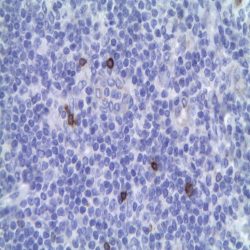
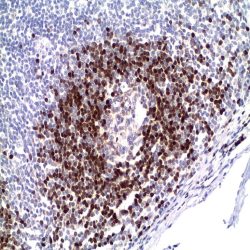
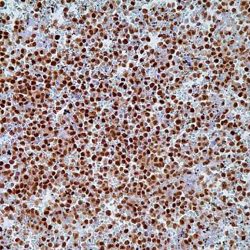
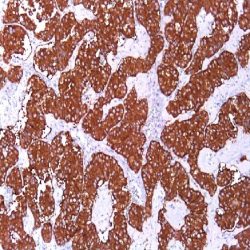
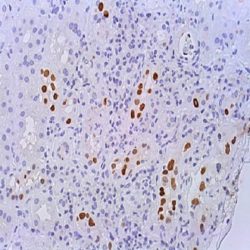
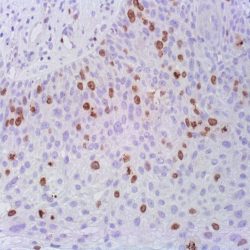
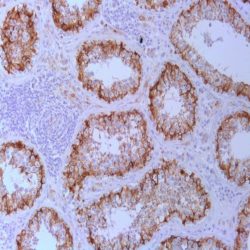
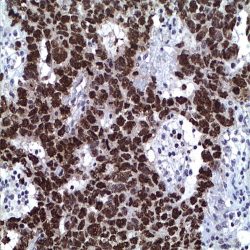
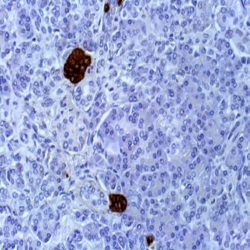
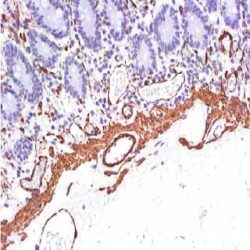
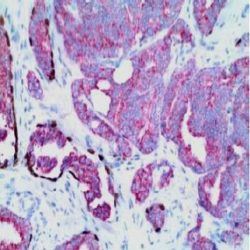
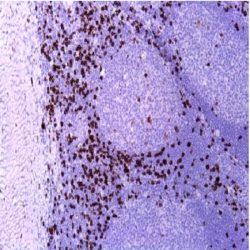
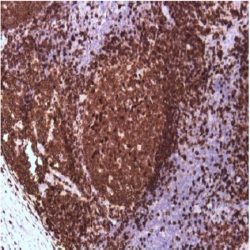
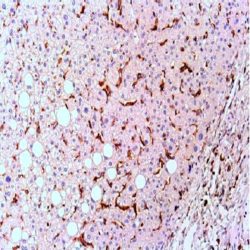
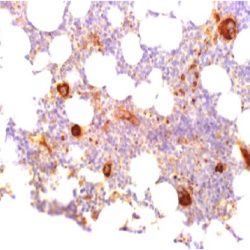
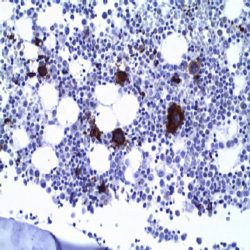
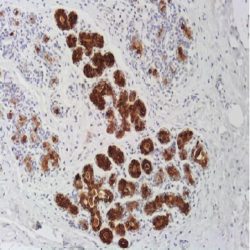

![Chemokine [C-X-C Motif] Ligand 13 (CXCL13) Polyclonal Antibody](https://samatashkhis.com/wp-content/uploads/2018/08/Chemokine-C-X-C-Motif-Ligand-13-CXCL13-Polyclonal-Antibody-2-250x250.jpg)
